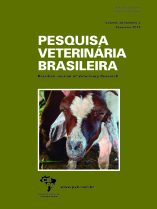 |
|
|
|
Year 2018 - Volume 38, Number 2
|

|
Hematological and biochemical parameters of neonatal Holstein calves supplemented with iron, 38(2):234-243
|
ABSTRACT.- Franciosi C., Rocha T.G. & Fagliari J.J. 2018. [Hematological and biochemical parameters of neonatal Holstein calves supplemented with iron.] Parâmetros hematológicos e bioquímicos de bezerros neonatos da raça Holandesa tratados com ferro suplementar. Pesquisa Veterinária Brasileira 38(2):234-243. Programa de Pós-Graduação em Medicina Veterinária, Faculdade de Ciências Agrárias e Veterinárias, Universidade Estadual Paulista “Júlio de Mesquita Filho”, Campus de Jaboticabal, Via de Acesso Prof. Paulo Donato Castellane s/n, Jaboticabal, SP 14884-900, Brazil. E-mail: thaisgrocha@yahoo.com.br
Iron deficiency in newborn calves is associated with the development of anemia, which favors the development of other infirmities such as pneumonia and diarrhea. The present study evaluated the effect of iron supplementation on erythrogram, serum levels of iron, ceruloplasmin and tranferrin, as well as potential toxicity of the protocol used by means of evaluation of urea, creatinine and hepatic enzyme activities. 40 newborn Holstein calves were allocated into 5 experimental groups comprising 8 calves each, which were subjected to the following treatment protocols: intramuscular administration of 5mL of sterile saline on the 5th day of age (control group G1), intramuscular administration of 5mL of 10% dextran iron in the following moments: on the 5th day of age (G2); on the 5th and in the 20th day of age (G3); on the 5th and 30th day of age (G4); on the 5th, 20th and 45th days of age (G5). Blood samples were taken until 8 hours after birth and with 5, 10, 20, 30, 60, and 90 days of age, and subjected to hemogram, evaluation of serum levels of iron, ceruloplasmin, transferrin, urea, creatinine, total and direct bilirrubin, and serum activities of aspartate aminotransferase (AST), alcaline phosphatase (ALP), and gamma-glutamyltransferase (GGT). Calves that received iron supplementation at any time presented less variation in the erythrocyte parameters, although calves in the control group did not develop anemia. Serum concentration of iron and acute phase protein ceruloplasmin and transferrin, which activities are related to iron metabolism, also increased, although not significantly. Serum levels of urea, creatinine, bilirubins and activities of AST, ALP, and GGT were not influenced by the administration protocols used in this experiment. The results of the experiment led to the conclusion that the supplementation with parenteral dextran iron in calves that receive diets other than exclusive milk does not bring sufficient advantages to be indicated, although more studies are necessary to evaluate the influence of iron supplementation on the outcome of infections in newborn calves, especially its influence on cost of treatment, time necessary for discharge and impact on its productive life.
|
| |
|
|
| |
|
 |